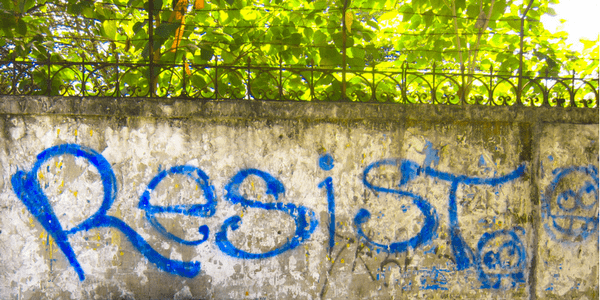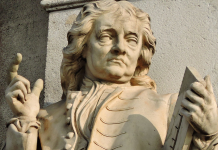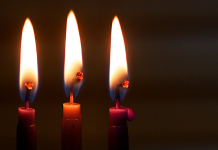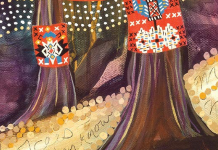 The current political climate of the world has been more than a bit troubling for many people across all walks of life. With new, strangely reptilian leadership and numerous policy changes in the United States that are leaving many people feeling powerless, hexing the evil-doers of the world is currently seeming like a lot more than just a whimsical suggestion.
The current political climate of the world has been more than a bit troubling for many people across all walks of life. With new, strangely reptilian leadership and numerous policy changes in the United States that are leaving many people feeling powerless, hexing the evil-doers of the world is currently seeming like a lot more than just a whimsical suggestion.
Fighting political battles with magick may seem like something that only appears in works of fiction, but there’s actually a long standing and varied tradition of these types of approaches. Magick has many uses and though some people may frown at its involvement in the political, the fact of the matter is that it has been in use for centuries to help people push against unfair regimes and survive hard times.

Magick in revolution: The Bois Caiman Ceremony
In 1791, the Haitian Revolution began, and in 1804, Haiti gained its independence. Today, this moment is often hailed as the most successful slave uprising of this era. What is most talked about is the fact that the revolution was led by slaves who after months of strategizing, successfully overthrew their masters and formed their own free lands. What is more whispered about but it also a well-documented part of this history is that the revolution started with a Vodou ceremony.1
This isn’t some Hollywood fantasy or an embellished fairytale, the beginning of this revolution started with the participants taking part in a officiated Vodou ritual, made even more powerful by the fact that these practices had been outlawed in the French colonies. The details of the specific ritual have been greatly debated and some people doubt that it actually happened at all, thinking of the ceremony instead as a historical myth created to for political reasons. There are sources that contest the validity of the ritual itself because of the lack of written records documenting it, and the place of mainly second hand accounts in its telling. However, Vodou is in some respects an oral tradition and given the cultural context and events that surround the ceremony — that of a slave uprising — it’s not surprising that there would be a lack of what most would consider official historical evidence.2
Even in the accounts that to assert that this ceremony took place, many different types of practices are mentioned. Some say that they merely worshiped their deities and performed prayers, while others are more salacious and claim that animals were sacrificed. The specifics of what spells were used or what words were said are less important in the history than the results, which were overwhelmingly positive.
Vodou was a huge part of why this revolution was so successful and not just because it called on the energy and power of the spirits and deities. Regardless of whether or not you believe in that portion of the history, it also is important to consider the fact that these shared practices and gods united people across the country in a way that just their common struggle may not have. The monolith of being “free” may seem like it would be a value shared universally by oppressed people, but history tells us that even enslaved people may wish to stay that way for their own reasons, or rather, that freedom is something that is often shrouded in complexity. Perhaps, in a sense, the shared cultural and spiritual practice of Vodou provided common ground for those who resisted slavery in Haiti. It was something they could use to see themselves as strong and independent, even in their very violent and uncertain times.
When we talk about magick and political action, we tend to see it as something directed to the forces we take issue with. However, it also serves to empower people, to bring them together, and to help them process what is happening around them.

Magick against Nazis, a lesson in psychic assault
In 1940, World War II was in full swing. The Third Reich was aggressively moving throughout Europe, and by 1940, France had succumbed to Germany.3 No country was safe from the advance of the Nazi army so it seems strange that England never had them set foot on their home lands. This could because of their military power… but it could also be because of group of witches who came together to turn back the Nazi forces.
Again, the workings and movements of witches and magick users throughout the centuries have been cloaked in shadows. This is also the case with the story that goes that a coven of witches gathered at night in New Forest to work magick against Hitler invading England in 1940.4
According to Gerald Gardner, the father of contemporary witchcraft, there was a gathering of witches who used a cone of power as a sort of psychic attack ritual against Hitler and his Nazi forces to keep them from invading their home country. In fact, the story is one tied to Gardner’s figure of Old Dorothy Clutterbuck — the woman through which he claimed to draw his magical lineage. Gardner’s legend claims that “Old Dorothy called up covens right and left; although by witch law they should not be known to each other.'”5 Much like the Haitian Vodou spells in the 1700s, accounts of what this ritual entailed and whether it was used at all are disputed.
Most of what we know about this event comes from Gerald Gardner, a familiar name as the founder of the modern practice of Wicca. Yet, there’s also a claim from Aleister Crowley‘s “son,” Amado Crowley, that his father was the mastermind behind the ritual. However, despite there being another witness to this event, Crowley’s own meticulous diaries do not contain any information about this nor about his supposed son. Although we can’t for certain say that Crowley did not work any magick with the specific purpose of pushing back the Nazis, it seems unlikely that it was on the same scale as the event that Gardner describes.6
Despite doubts about historical details, this story persists and what makes it most interesting is the manner in which they resisted. The idea is that the cone of power would psychically effect the advancing forces, preventing them from crossing into England. That’s it. It wasn’t a working that ensured that the British forces were so great that they would overcome the Nazis, or that an advance would fail, just that the opposing forces couldn’t cross the water to get there. There was no thought of harm, just protection.
This spell work was very subversive and instead of putting energy into something in the physical realm, the focus was in the spiritual and mental. For what it’s worth, the Nazis did not set boots on the ground in England so this attack would be considered a success in that case. There are many historical and political reasons why this was the case, that doesn’t mean this movement didn’t have an influence over how things played out during the war itself.
The effects of magic, even when directed at our “enemies” aren’t always clear cut and apparent, and usually, we might see this as a bad thing. This plays very strongly into the sort of protest magic that is happening today against leaders such as President Donald Trump.(( Ephrat Livni, “Feminist Witches Are Casting Hexes on Donald Trump,” Qz.com, 2 November 2016.))
There have been multiple gatherings where magick was cast and energy directed to his downfall. Many of these are seen as having been failures because he is still in the White House today however, perhaps if we look at it from a different angle we can gain a new appreciation for what is happening in the present moment. Although no hexes seemed to stop his rise to power, for example, his presidency has been beset with a number of hiccups and a unparalleled amount of protest and resistance. Perhaps what is happening today is more like that of what happened in 1940 which is ironic, considering the current political climate.

Hexing as justice and protection
In 1980, the Bay Area near San Francisco, California was beset with a series of violent attacks from a serial killer, leaving many women worried about being targets.7 The police hadn’t been able able to catch him so Zsuzsanna Budapest — founder of the Dianic tradition of witchcraft — called upon other witches in her area to perform a hex with the power of the Dark Goddess to put an end to it once and for all.
In Budapest’s The Grandmother of Time (1989), we are given a first-person account of what was done to bring the killer to justice. The ritual was performed under the light of a full moon eclipse and called on aspects of the Dark Goddess such as Hecate and Kali to lend their power to the spell. The women called on the the killer to be caught by his own mistakes.
This account speaks of the issues surrounding using magick for “harm” with the idea that it will come back on the caster threefold. This isn’t a discussion had in the aforementioned examples, but it is certainly one that we see happening in modern settings. What are the ethics of hexing? For Budapest, she sees those with evil intent as only existing on the physical plane — “their souls saddened by the evil they are doing.”8 Ultimately, this is what will bring their demise, and the spell was cast, as Budapest notes, to make the murdered succumb “by his own mistakes, by his own fault, by his own evil.”9
The hex did work, and the killer was captured three months later. Using magick in this way, directly, to harm someone is often frowned on but the other side of it is that harm is secondary for the protection it offers the people who are casting it. As Z asks, why are hexes more difficult to accept than “taking self-defense lessons and learning how to gauge a man’s eyes out?”10
This form of resistance allows people who feel powerless to take back their power. It allows them to seek justice where justice has thus far been denied.
It’s no surprise that this same tactic has been taken up in modern times against rapists. A call was put out in June of 2016 after Brock Turner, the Stanford Rapist, was given a laughable light sentence in light of the heinous attack he had been convicted of. Melanie Elizabeth Hexen put out a call through Facebook for witches to join her in hexing the man.11
Although we don’t know if the hex worked for certain, much like Z’s call in the ’80s, this was a way to give power back to the powerless and seek justice in the name of violent oppression.
The magick in protest, the magick to resist
All of these incidents are drastically different from one another but they all share a common thread and that thread is that they put power in the hands of ordinary people, who seek to push against oppression and harm.
When these stories are highlighted by the media, they are done so as fluff pieces because the work isn’t taken seriously and if something negative happens anyway, people are told, “See, magick doesn’t work.” But what these lessons from history tell us is that it is not that magick doesn’t work, only that it doesn’t work the way that we think it should.
Magick is only one part of how we can protest. Just because the people we stand against don’t fall over dead doesn’t mean that our magick isn’t powerful and sacred. Sometimes it manifests in other ways but sometimes, the point of our magick is to give us the strength to resist.
Image credits: Carlo Villarica, sbmeaper1, Scott Johnson, and Jordi Roy Gabarra
- “The Haitian Revolution 1791,” History of Haiti, 27 October 2015. [↩]
- “Haiti: The Bois Caiman Meeting of 1791.” [↩]
- Ronald Hutton, The Triumph of the Moon (New York: Oxford University Press, 1999), 208. [↩]
- “How a Coven Impacted Hitler and WWII,” Articles, 22 October 22. [↩]
- Hutton, Triumph, 208) Who were these witches? The New Forest Coven? Other magical powerhouses? Some of the more dramatic recounts of the event include “frenetic dancing and chanting,” which in turn, resulted in the passing of some older participants in the ritual. ((Ibid. [↩]
- Ibid. [↩]
- Zsuzsanna Budapest, The Grandmother of Time (New York: HarperSanFrancisco, 1989), 61. [↩]
- Ibid. 61 [↩]
- Ibid., p. 63 [↩]
- Ibid., 61 [↩]
- “Witch Organizes Mass Hex to Curse Brock Turner,” New York Daily News, 9 June 2016. [↩]








